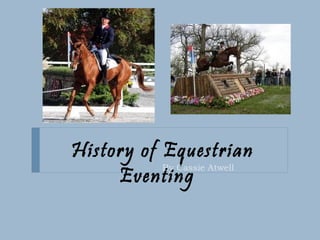History of equestrian eventing
- 1. History of Equestrian Eventing By Cassie Atwell
- 2. Index: Mechanics of Eventing Dressage Cross Country Stadium Jumping Scoring Origination of Eventing Olympics Rolex Quiz
- 3. Mechanics of Eventing EventingŌĆÖs 3 stages remain composed of dressage, cross country, and stadium jumping. Dressage: the guiding of a horse through a series of complex maneuvers by slight movements of the riderŌĆÖs hands, legs, and weight, a harmony between horse and rider. Cross Country Jumping: an endurance test, stretching over varies terrain, where the horse and rider not only compete against the obstacles but where they must also complete within a specific Stadium Jumping: riding horses in a competition over set courses to demonstrate skill in jumping over obstacles.
- 4. Dressage Scoring is based off of the results of your dressage test. Where judges score each movement of the pattern on a scale of 1 through 10. The pattern must be memorized previously. For example, if a twenty meter circle is required, the judge will specifically give you a score on that specific movement. When the test is complete, the entire test with multiple movements will be added up providing the overall score. http:// www.youtube.com/watch?v=tTpKcyrdLR8
- 5. Cross Country Jumping Cross country for many, persists to be the hardest phase of Eventing. Cross country courses are several miles of uneven terrain, must be completed within a certain amount of time, and are all immovable solid fences. Horses are required to go through water, down drops, up banks, over ditches, at a quick pace. If horses refuse to go over a fence or complete the course too fast or slow penalty points will be added on to the Dressage test. If a horse or rider falls, elimination from the show follows. http://www.youtube.com/watch?v=R9EEsV2Djds
- 6. Stadium Jumping Stadium, unlike cross country, lies within an enclosed arena with the course lasting between 2-3 minutes. Fences easily fall down, requiring the horse to be particularly careful with its legs. Although this phase may not appear to be as challenging as cross country, by the third phase horses begin to tire. Stadium requires detail and meticulous talent to complete without knocking over a rail. These fences are brightly colored and decorated, an easy distraction for a fatigued horse. Penalties include time faults (going to fast or slow), refusing a fence, or knocking over rails. http :// www.youtube.com/watch?v=yb7vz8vnd9A
- 7. Example of Scoring This is an example of a score sheet. LetŌĆÖs say, that horse and rider, team A, received 150 points out of 190. They are now riding on 40 penalty points. Moving onto the next phase of cross country, the horse refused to jump a fence, therefore affecting their time putting them over the time limit. This adds on 20 penalty points for refusing along with 10 time faults. Now changing their score from 40 to 70. In Stadium they knock over 3 fences but are within the time limit. Each rail costs them 4 points. This now means they will end the show with 82 penalties as their final score.
- 8. Origination of Eventing Eventing originated in the French militia, to show balance between horse and rider. France created the first event called ŌĆ£Raid Militaive,ŌĆØ the beginning to Eventing. This served as an extended training event in the 1800ŌĆÖs for Calvary horses. It served to showcase the skills and talent between horse and rider. http://www.youtube.com/watch?v=Q7MIOk0bTk0
- 9. Olympics Eventing entered the Olympics in 1912. For 40 years, only male military officers were allowed to compete. In 1952, it opened up to civilian men. It was not until 1964 that women entered into the Olympics. Equestrian sports remain the only Olympic sport where men and women compete against each other.
- 10. Rolex Rolex Eventing is held in Lexington, Kentucky. Rolex remains the highest level of Eventing competition in the states, a 4 star level. The same as Olympic riding. It is sponsored by Rolex watches, and last over 4 days; Thursday through Sunday. The winner receives $65,000, along with a Rolex watch. Rolex takes place the last weekend in April, a week before the Kentucky Derby.
- 11. What have you learned? What country did Eventing originate? How many phases make up Eventing? Name two differences between stadium and cross country jumping? What makes Eventing special in the Olympics? What state is Rolex held? Who is the sponsor?
- 12. Bibliography http://www.biologydaily.com/biology/Horse http://www.horses-and-horse-information.com/articles/three-day-eventing.shtml http://en.mimi.hu/horse/eventing.html http://www.youtube.com/watch?v=R9EEsV2Djds http ://encyclopedia.thefreedictionary.com/cross+country+jumping http:// www.rk3de.org/index.php












